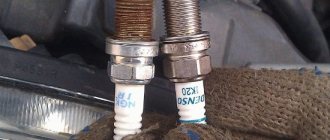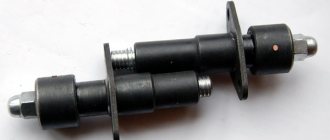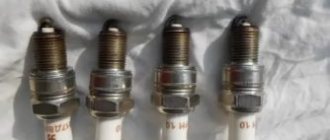Any experienced motorist knows about the importance of the question of how long it takes to change spark plugs, because the performance of the engine directly depends on this part. Regardless of the type of fuel mixture, be it gasoline or gas, the igniter must produce a sufficiently powerful spark and operate smoothly. When performing a technical inspection of a cylinder block, special attention is paid to the distance between the electrodes, which will be increased in worn samples. Because of such seemingly insignificant little things, the car will stop working in the mode familiar to the owner.
How to determine the condition of spark plugs
When the spark plugs are worn out, the first thing that catches your eye is the engine starting to stall. Other vibrations, noises and unstable speeds begin to appear. Before going to a service station, you can save money and try to determine the condition of the spark plugs yourself.
First, determine the gap between the electrodes, their sizes and the level of carbon deposits. You can find out what size electrodes should be for your brand of candles from the instructions. If there is a large gap, it means that the spark plug has already served its purpose and needs to be replaced.
Ideal when there is no soot at all. If it is, it means that the fuel is not burning as it should. Also look at the condition of the ceramic insulators. They must be free of cracks and defects.
For other reasons why you should replace spark plugs, watch the video.
If during inspection you find damage, replace the spark plug, or it is best to replace the entire set. This will make the engine run more stable. Also, the frequency of replacing spark plugs depends on their type. Platinum and iridium spark plugs can operate flawlessly for up to 80,000 km. Conventional ones only last 10–20,000 km.
Guess which spark plug is faulty
It's not uncommon for an engine to feel like it's stumbling or just running, but all of the spark plugs appear fine and even free of carbon deposits. What to do in such a situation if we do not want to change the entire set at once?
Just disconnect each plug in turn from the wiring and observe the behavior of the motor, take it into account. The source of the problems is the spark plug, which does not change the engine's performance.
True, the cause of engine malfunction is not always the spark plug. Instead, after the replacement, you will realize that the problem is definitely not traffic jams.
How often to change spark plugs
How often spark plugs need to be changed on a particular vehicle is usually documented. For your convenience, the manufacturer indicates which brands of spark plugs it recommends to use and how often they should be changed: after what time or mileage.
In fact, a lot depends on the type of plugins themselves. For example, platinum is exchanged for 50-60 thousand. km, and iridium 100 thousand km. However, they are more expensive and are rarely used. Usually cars are equipped with classics, which need to be changed after 10-20 thousand. km mileage By the way, under favorable conditions and periodic cleaning, it can have the same 50 thousand. mileage.
And even if you have 50 thousand in your papers. km, and in a year you have driven no more than 15 thousand. km, at your next inspection you will be asked if you want to replace the spark plugs. And it is right.
Experienced drivers and service technicians agree that spark plugs should be replaced once a year. Moreover, this should be done in the fall in preparation for the winter period.
Why in autumn?
When the weather worsens (ice and snow), the operating conditions of the vehicle deteriorate sharply. Also, negative temperatures play an important role. All systems, including the ignition, work under increased load in winter and will fail if there are any problems. Thus, by winter the car should achieve maximum performance.
Prevention
- To avoid replacing spark plugs frequently, watch what you put into the tank and avoid “left-handed” gas stations.
- Check the condition of the spark plugs regularly, for example, every 5 thousand km. This will save you from excessive fuel consumption and unpleasant surprises on the road, especially in winter.
- Buy a set of spark plugs and carry them with you, as they say, just in case.
- Monitor the engine oil level and condition.
- Buy only high-quality spark plugs, preferably those recommended by the manufacturer of your car, but this does not mean that others are contraindicated for you. You have the right to choose similar spark plugs, the main thing is that they match the parameters (operating temperature, heat rating, number of side electrodes, thread diameter, etc.). Leading manufacturers of spark plugs: NGK, BOSCH, Brisk, DENSO.
Geometric parameters
Spark plugs can have different geometric parameters:
- Thread diameter - 10, 12, 14 or 18 mm.
- The threaded part - the candle skirt - is of different lengths.
- Different spark gap - 0.9-1.1 mm.
- The body shape is cylindrical or conical. A spark plug with a cylindrical body will have a sealing washer; in the case of a conical body, a washer is not needed.
Geometric parameters depend on the design features of a particular engine - they must be exactly as required by the manufacturer. If instead of the required spark plug you install an “almost the same” but slightly different one, at best the engine will not work normally, at worst - expect trouble.
For example, if the spark plug has too short a thread, the electrodes will be located much higher than necessary, which means the spark will not form where it is needed. Misfire will occur and the engine will lose traction. It will also begin to shake, and fuel consumption will increase: a significant part of it will not burn and will fly away into the atmosphere.
If the thread is too long, there are two options:
- the spark plug will overheat and glow ignition will occur;
- the spark plug will simply hit the piston and you will either have to do a major overhaul of the engine or buy a contract one.
What happens if you don't change the spark plugs?
There are a sufficient number of scenarios according to which events will develop in the future. The first, most common option is that at one point you will not be able to start your car, and most often this happens at the most inconvenient moment. There will most likely be absolutely no signs before this, and then bam, and you can no longer start the car.
If you hear engine friction at idle, then this is a bad sign that screams that it’s time to urgently change the spark plugs. In the future, if you do not change the spark plugs, the gap between the electrodes will greatly increase, and this will increase fuel consumption. If you continue to drive the car and do not change the spark plugs, the ignition coils will simply break. The procedure for replacing coils is not that cheap, so your negligence will hit your pocket hard.
If there are defects in the operation of the internal combustion engine, then this can also affect the spark plugs. For example, if the spark plugs constantly work while completely covered in oil, this will have a bad effect on their performance. The problem in this case is that the internal combustion engine gaskets have become unusable and need to be replaced.
Sometimes the spark plug does not spark because the contact has bent slightly during operation and the gap has changed. If you are far away and there is no way to purchase candles, you can temporarily set it up on your own. To reduce the gap, you can use a vice, and to increase it, you can simply use a coin. For convenience, below is a table of gaps for the most common spark plugs.
The importance of correct spark plug installation
The consumable element in question is often rendered unusable by its incorrect installation. The tightening torque of the candles plays a big role here. For each of them, the required moment is indicated on the packaging, but not everyone pays attention to it, and if they do, they consider this parameter to be of little significance. Therefore, not all motorists have a torque wrench - you can tighten it by hand to a certain angle. Practice shows that the torque with seemingly the same tightening force can differ by tens of N*m.
A smaller torque cannot provide the required level of tightness and fastening reliability. High, on the contrary, leads to disruption of the thermal characteristics of the candle and damage to the threaded part. Recommendations for tightening the spark plugs to a certain angle largely only prevent their incorrect operation, but this method is by no means correct, so it is important not only to know at what mileage to change the spark plugs, but also to install them correctly.
Which spark plugs are better for VAZ 2110
AU17DVRM
The original spark plugs for all VAZs are AU17DVRM. These spark plugs from the domestic manufacturer are of excellent quality and have proven themselves well in the market. AU17DVRM are an excellent alternative for replacing spark plugs, as these spark plugs have good spark formation, reliability and durability, and are also not inferior to imported analogues.
NGK No. 11
NGK spark plugs have performed well on the market and are one of the most popular spark plugs for domestic cars. Most Lada owners prefer NGK No. 11 spark plugs. These spark plugs have a long service life and high reliability.
How to understand that spark plugs need to be replaced
There are a large number of signs that indicate that the spark plugs should be replaced with new ones. You should be aware that at the moment a spark appears between the electrodes, the temperature is enormous; with prolonged use, this leads to wear of the spark plugs.
Old and new spark plugs
Here are the main signs that may indicate a problem with the spark plugs:
- You have completely stopped feeling the dynamics of car acceleration.
- Fuel consumption has increased noticeably over the last period of time.
- After the first turn of the key, the car refuses to start, and you have to make several attempts.
If we consider the signs in general, they can also indicate problems in other systems, so we need to understand them in more detail. That is why, in order to find out whether there are problems in the spark plugs, they need to be unscrewed and inspected.
Replacement process
Tools and materials:
- Special key for candles;
- Compressor.
Progress:
- Unscrew and put aside all unnecessary elements.
- Disconnect the high-voltage wires, hold only the tip.
- Blow out the spark plug well using a compressor.
- Use a spark plug wrench to unscrew the old system element.
- Assess the condition of the parts.
- Whether an old or a new spark plug, when screwing it into place, press it with your hand so that the thread falls into place.
- Replace the high voltage wire.
- So check all the spark plugs.
- After checking and replacing, screw back all previously removed parts.
In almost all cars, spark plugs are changed in the same way. The only difference is the number of parts that need to be removed.
What does a spark plug consist of and what functions does it perform?
So, a little theory! If anyone doesn’t know, a spark plug is necessary to ignite the fuel-air mixture in the engine cylinder. That is, as many cylinders as there are spark plugs. The spark plug consists of 6 main parts. Each of them has its own function.
| Element | Function |
| 1.Pin pin | connects the spark plug to the car's electrical wiring |
| 2. Central electrode 3. Side electrode | form a potential difference to cause a spark to occur |
| 4.Insulator | prevents the spark plug from overheating |
| 5.Insulator ribs | prevent breakdown from occurring on the outer surface of the insulator |
| 6.Seal | protects against penetration of hot gases |
Proper operation of the spark plug ensures efficient combustion of fuel in the engine, saves fuel and protects the engine itself from premature wear.
At the same time, the candle itself is forced to remain in extreme conditions and withstand such phenomena as:
- heat
- high pressure
- electrical voltage
- spark impact
And deposits often appear on the spark plug due to low-quality fuel. Or due to the presence of various additives in fuel and oil.
Sooner or later, any of these factors will lead to spark plug failure. Sometimes this happens gradually (for example, carbon deposits form), sometimes instantly (breakdown occurs).
Purpose and principle of operation
The purpose of engine spark plugs is to form a spark that ignites the fuel. The elements of the spark plug are subject to high loads, and they are also under the aggressive influence of chemicals formed as a result of incomplete combustion of fuel. The temperature that the parts have to withstand ranges from 70 to 1.2 thousand degrees, and the gas pressure can reach 60 bar.
Important
The design of the candle, as well as the materials used in its manufacturing process, must be as strong, reliable, wear-resistant as possible, and at the same time have stable performance characteristics.
The ability of the spark plugs to uninterruptedly perform their functions determines such characteristics of the engine as its power, starting qualities, fuel efficiency, as well as the composition of the exhaust gases.
As mentioned above, the purpose of a candle is to create a spark and to maintain this spark for a certain time. To cope with the task, it is important that the low voltage from the battery is converted into a high voltage, sometimes reaching 40 thousand V. This conversion occurs in the coil, after which it is transmitted to the electrodes of the spark plug (there is a gap between them).
One of the electrodes (central) receives a “plus”, while the “minus” goes to the side. When a voltage is generated on the electrodes sufficient to overcome the resistance present in the gap (experts call this a breakdown), a spark appears.
Signs of wear
The following factors may indicate a malfunction of the SZ:
- reduction in engine power;
- increased fuel consumption;
- engine tripping;
- problems starting the engine.
All problems are related to sparking of the spark plug. It is necessary to diagnose and promptly replace damaged elements with new ones.
Gap Study
An important detail of the SZ is the correctly set gap between the electrodes. During vehicle operation, the contact materials wear out and the gap increases. As a result, sparking is disrupted, breakdown voltage increases, and fuel consumption increases.
When preparing your car for winter, you must check and adjust the gap between the electrodes using a round feeler gauge, taking into account the required dimensions.
Presence of soot
When inspecting spark plugs, you first need to pay attention to carbon deposits, which are conductors and create current leakage. Over time, the deposit increases, the voltage between the electrodes disappears, and the part stops functioning.
The gray-yellow or light brown color of the carbon deposits does not affect the operation of the engine and does not need to be cleaned. It is not advisable to unnecessarily leave scratches on the electrodes, because... they contribute to the accumulation of soot. If the carbon deposits are black, the candle must be placed in a prepared container with gasoline or solvent and held for 30 minutes. Then use a wire brush to clean off the carbon deposits. After this procedure, the device must be thoroughly dried.
Ceramic insulator
The SZ insulator is made of aluminum oxide ceramics, which can withstand temperatures of 450-1000 ° C. The part adjacent to the electrode greatly affects the quality of the element’s operation.
Black or brown deposits on the insulator of the part indicate a breakdown of the exhaust gases or a malfunction of the high-voltage wires.
Signs of engine operation to replace spark plugs
- The engine does not start well . If the driver notices that the engine does not start immediately after a long stay, but only the second or third time, then the car lets you know that it is necessary to clean or replace the spark plugs. This is due to a low-power spark between the electrodes of the spark plugs, so the combustible mixture does not ignite completely, or does not ignite at all.
- Exhaust gases are black . This indicates a large amount of combustible mixture in the combustion chamber. Due to poor performance of the spark plugs, the spark does not ignite the entire volume of the mixture accumulated in the combustion chamber, so fuel detonation occurs, leading to the appearance of black smoke. Large detonation gradually destroys the surface of the cylinders and pistons.
- The motor shakes during operation . If, when driving and accelerating, the driver feels uneven operation of the engine, this means that the piston group is not functioning correctly; some pistons do not create the necessary force on the crankshaft. This occurs due to the fact that the mixture is not ignited in all combustion chambers.
- The presence of a large amount of fuel in the catalyst and exhaust system . If you carefully visually inspect the exhaust pipe while the engine is running, drops of water fly out of it. Under normal conditions, condensation always forms, but if liquid comes out of the pipe in significant quantities, this indicates that the fuel is not completely burned. In such a situation, one can assume the formation of a weak spark that is not able to ignite the fuel mixture, or it does not burn completely.
- Reduced power . If, while driving, the driver sees that the car is accelerating slowly or moving unevenly, then the engine signals that the spark plugs are not functioning properly.
In such cases, it is necessary to replace spark plugs that have not yet reached their expiration date. You need to know that without the high-quality functioning of the ignition system, the engine will reduce power, and a high temperature will be created inside it, created by a large amount of combustible mixture, which will lead to damage to the piston rings and the penetration of engine oil into the combustion chamber. When the spark plugs reach the end of their service life, they must be replaced.
Spark plug malfunctions: what causes them
Spark plugs break quite often, but in fairness, we note that recently, thanks to improvements in manufacturing technology, the service life of parts has increased compared to analogues produced 30 years ago. The most common component failures include:
- Formation of carbon deposits on the electrodes and the top of the insulator.
- Reducing the gap and its contamination.
- The appearance of cracks in the insulator.
- Depressurization.
The fact that the spark plugs have failed is indicated by problems with starting the engine, its uneven operation and a sudden stop.
Depending on the nature of the breakdown, various factors can lead to its occurrence. If the electrode and the part itself are covered with soot, there is a possibility that the mixture in the chamber is incorrect, in particular, there is too much oxygen in it. Such deposits can also be caused by a dirty air filter that requires replacement, malfunctions in the injection system, etc.
When oily deposits appear on the spark plug, it means there is too much oil in the combustion chamber, which indicates wear on the pistons and rings, valves and cylinders. In cars with a turbo engine, such a malfunction becomes a consequence of the failure of the turbocharger.
Center electrode material
One of the goals that engineers have when choosing a metal for electrodes is to slow down their wear. A spark is a stream of charged particles - electrons and ions. They move at great speed in the electric field between the electrodes, and when they meet their surface, they knock out metal atoms from them. The electrodes gradually lose substance and “burn out,” but this process can occur in different ways: it all depends on the alloys and metals at the ends of the electrodes. Manufacturers' catalogs contain mainly nickel, iridium, platinum and, less often, silver spark plugs.
Nickel is used to make budget spark plugs. It is inexpensive, easy to mass produce, and relatively refractory. On average, nickel spark plugs last up to 40,000 km without interruption. They are used in engines with a volume of up to 1.6 liters with a low compression ratio, which run on AI-92 or AI-95 gasoline.
Silver has high thermal conductivity and can operate over a wide temperature range. Therefore, spark plugs with a silver central electrode are used in engines that run on gas and sometimes gasoline. Service life - up to 50,000 km.
Nickel spark plugs have a fairly thick central electrode - approximately 2.5 mm in diameter. It is mainly composed of an alloy of nickel and chromium. Silver electrode - slightly thinner, approximately 2 mm in diameter, consists primarily of silver.
How do you know when it's time to change the spark plugs?
How often to change spark plugs is determined not only by the mileage of the car, but also by the condition of the spark plugs themselves. There are a number of signs indicating possible faulty spark plugs:
- Strong smell of gasoline from the catalyst (indicates that the fuel is not completely burned).
- Increased fuel consumption (due to misfire).
- Difficulty starting the car engine.
- Unstable engine operation (troits, stalls, gains speed poorly, shows reduced power, jerks). Sometimes detonation and other extraneous sounds are also clearly audible.
- Change in the nature of the exhaust gases (soot and odor appear, and the analyzer will show increased CO).
- Visual defects of the spark plug (cracks, chips, melting, uneven color of electrodes, carbon deposits).
- The “CHECK ENGINE” signal lights up on the dashboard.
If any of the above is observed in your car, it is advisable to check the spark plugs.
When it’s just a matter of carbon deposits, you can clean it off, and then the candles will work for some more time. If the spark plug is covered in oil or has a strange coating, it makes sense to change the brand of oil and start refueling elsewhere. If the spark plug shows obvious signs of destruction, definitely replace it!
How to increase spark plug life
To extend the life of spark plugs, some car enthusiasts use so-called traditional methods; we will describe one of them in more detail.
To ensure safety, you should disconnect the ground or remove the terminal from the battery, disconnect the cables, and remove the spark plugs. Then you need to measure the required length of the side electrode, mark the section to be cut off, and clamp the body of the part to securely fix it, but not damage it. Carefully remove the excess part of the electrode, and process the cut with a file so that there are no burrs.
Using pliers, bend the electrode so that the edge matches the height of the central electrode and the gap matches the nominal value. The described procedure should be repeated on each part, then after modernization, screw them into place and connect them in accordance with the design features of the power plant.











